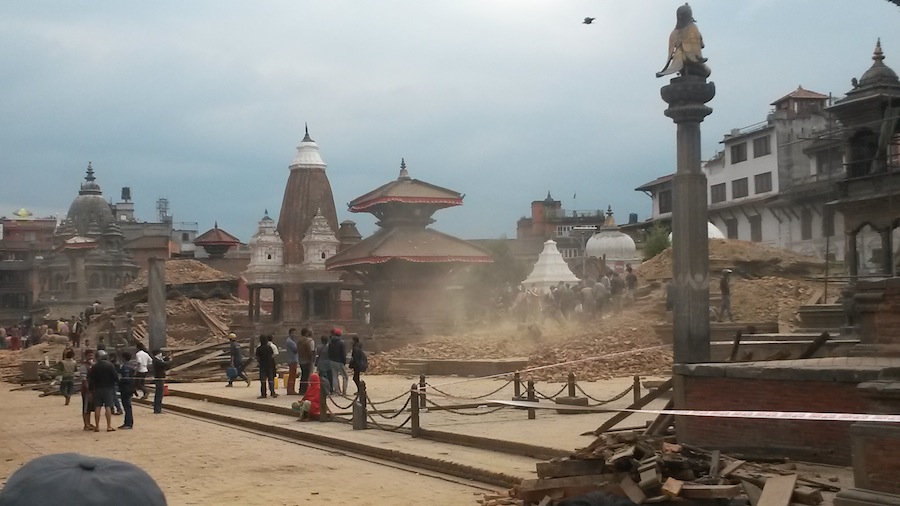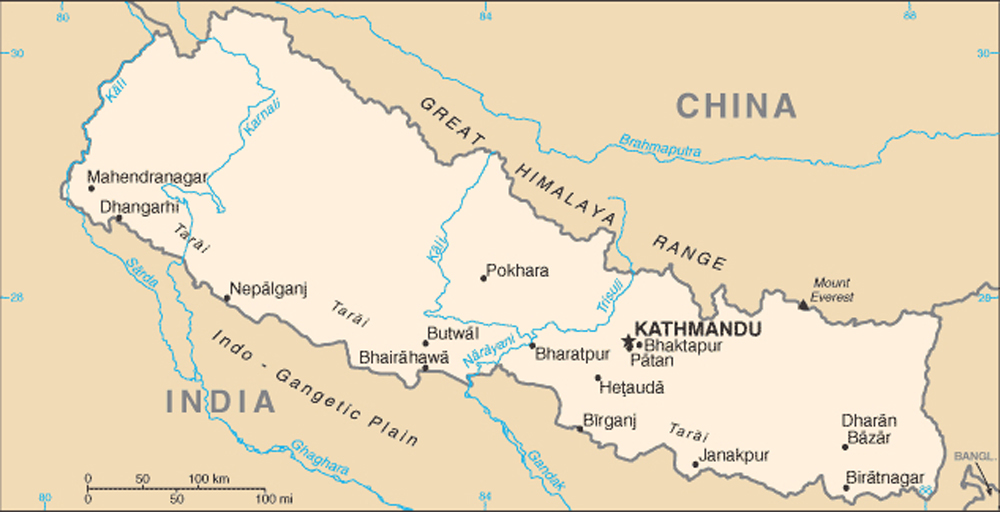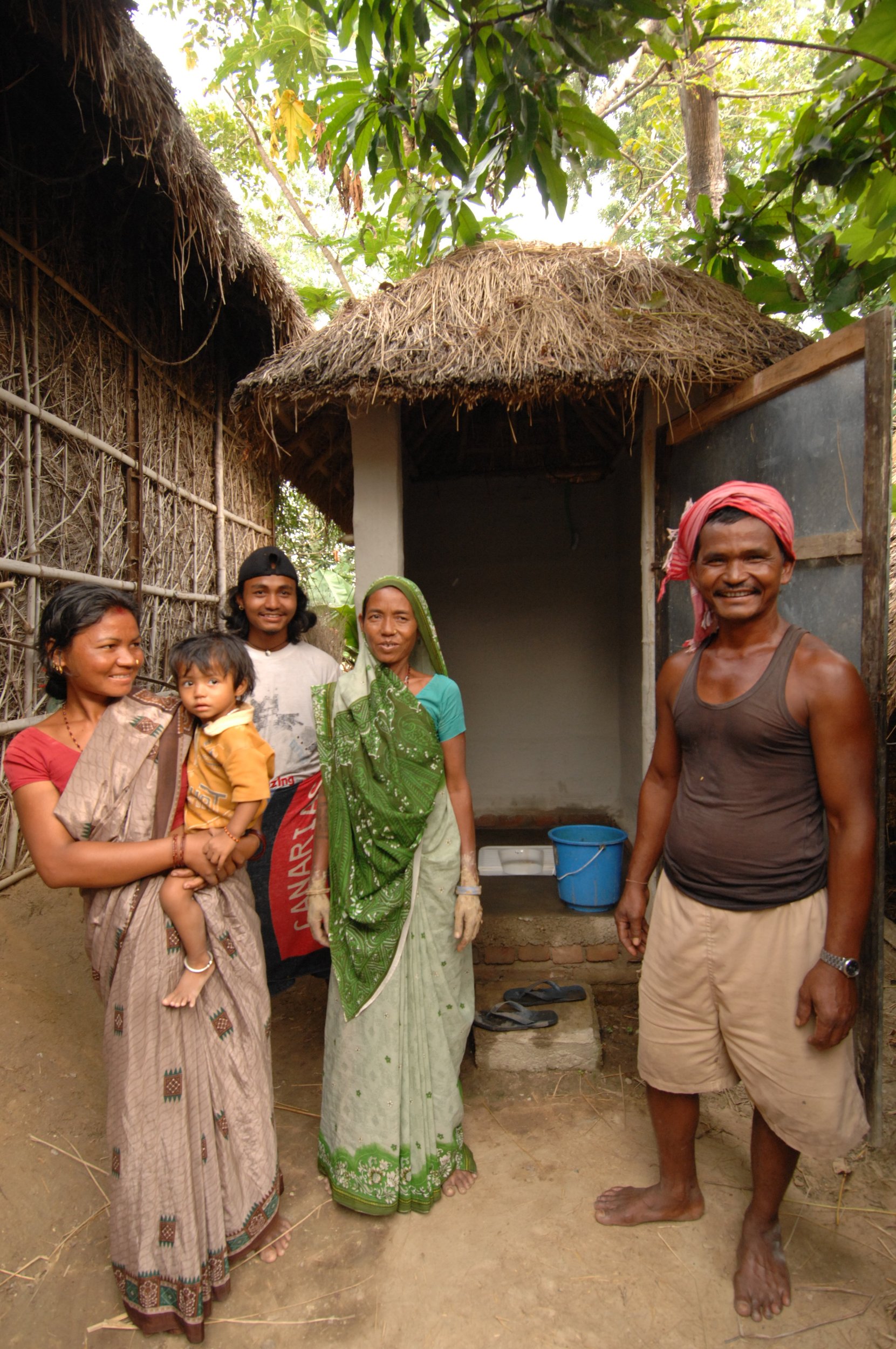Nepal: Facts About Geology & Culture

Nepal is a narrow, landlocked country directly north of India and below China. It is relatively remote with topography ranging from lowlands in the south, and hilly and mountainous regions in the north. The climate is just as varied and ranges from tropical to alpine.
"In the lowlands it can be very warm and humid, whereas in the temperate and alpine regions the temperatures are cool to cold, the latter supporting very few permanent settlements," said Dale Schneeberger, a professor of geology at Biola University in Mirada, California.
Though there are limitations as to where homes and villages can be built, Nepal has a population of 30,986,975, according to the U.S. Central Intelligence Agency (CIA). Most people live in the capital, Kathmandu, or in the southern plains. Nepal has an area of 56,827 square miles (147,181 square kilometers), about the same as Arkansas. It is about 500 miles (800 km) long northwest to southeast and 125 miles (200 km) wide. The elevation in Nepal ranges from Mount Everest, the highest point on Earth, at 29,029 feet (8,848 meters) above sea level, to only 230 feet (70 m) above sea level in Kanchan Kalan.
Quake-prone area
In April of 2015, the small county was rocked by a 7.8-magnitude quake. More than 6,000 people died as a result and over 13,000 injured, according to BBC News. The destruction was particularly deadly due to how the people in Nepal live.
"From my personal travels in the extreme northeastern part of India (Silchar, Assam), about 400 miles [644 kilometers] east-southeast of Kathmandu, it is apparent that there is a mix of quasi-modern and poor rural." said Schneeberger. "As with any part of the non-industrialized world, building codes, where they do exist, may or may not be enforced or are only partially followed. Many structures are of un-reinforced stone/brick (masonry), many of which can be very old and of historical significance."
Un-reinforced masonry is very susceptible to seismic shaking from an earthquake and is one of the most common reasons for injuries or deaths during these events, Schneeberger said. Without proper design and reinforcement, buildings and structures of this type fall during the main earthquake or from the many aftershocks that follow as people try to rescue survivors or personal items.
Samrat Upadhyay, the Martha C. Kraft professor of humanities at the Indiana University School of Global and International Studies, said the recent earthquake in Nepal is reminiscent of another that took place in 1934. That quake, with a magnitude of 8.1, killed 10,600 people. "We had been warned. In the early '90s, when I returned to live in Nepal for two years, the country experienced mild earthquakes," said Upadhyay, whose parents survived and are camping on the outskirts of Kathmandu.
Get the world’s most fascinating discoveries delivered straight to your inbox.
The massive earthquakes are caused by movement of tectonic plates in the Himalayas. Similar seismic activity created the mountain peaks of the Himalayas, said Upadhyay. According to National Geographic, Nepal is one of the most earthquake-prone areas in the world because it is on a major fault line, where the Indian subcontinent meets the Asian continent. The Indian plate continues to push northward about 1.7 inches (4.5 centimeters) per year.
Customs
People of Nepal are called Nepalis. Nepali customs can usually be traced back to Hindu, Buddhist or other religious traditions, according to the Nepal Tourism Board. For example, Nepalis is divided by the pure and impure. Food or materials touched by someone else's mouth is considered impure. Cow dung, on the other hand, is considered to be pure and is used for cleansing purposes. Women are considered impure during menstruation and are kept in seclusion until a purification bath is taken on the fourth day.
Nepal is a patriarchal society, meaning that men are in charge. They usually work while women take care of the home and children. Marriages are often arranged by parents after the boy or girl comes of age, and most people only marry inside of their caste.
Languages
There are 101 ethnic groups that speak over 92 languages in Nepal. Nepalis speak mostly Nepali, which is the official language of the country. Other languages are also spoken in Nepal, including Maithali, Bhojpuri, Tharu, Tamang, Newar, Magar, Bajjika, Urdu, Avadhi, Limbu and Gurung, according to the CIA.
Religion
While Nepal is thought of as a Buddhist nation, many people who live there practice other religions. Nepal became a secular country by order of the parliament on May 18, 2006, according to the Nepal Tourism Board. Actually, most people — 81.3 percent — are Hindu, while 9 percent are Buddhist, 4.4 percent are Muslim, 3.1 percent are Kirant and 1.4 percent are Christian, according to the CIA.
Nepal food and drink
Nepalis do not eat beef, typically because Hindus worship cow and cows are the national animal of Nepal, according to the Nepal Tourism Board. Nepali food is influenced by Indian and Tibetan styles of cooking. A typical meal consists of dal, a lentil soup, bhat, which is boiled rice, and tarkari, which is curried vegetables.
Nepalis also like to eat achar with their meals, which is a type of pickle. Curried meat is eaten on special occasions and momos, which are steamed or fried dumplings, are a popular snack.
The arts
Nepal is known for its beautiful temples. Unfortunately, many temples have been destroyed due to earthquakes. These temple were centuries old and were prized for their exquisite carvings. "Kathmandu Durbar Square is in ruins. Patan Durbar Square has been devastated. These were World Heritage sites so, in a very literal sense, the whole world has lost physical access to its cultural history, said Upadhyay.
Business culture
The enclosed shops and businesses found in Western countries are not typically found in Nepal. "Life in this part of the world is way different than in the industrialized West," said Schneeberger. "Many things are available but not like the so-called first-world cities. Open markets with vendors selling various produce, meats and other goods (clothing, etc.) are common."
Holidays and celebrations
Many of the holidays in Nepal are Hindu festivals. These festivals have no set date and follow astronomical observations. For example, Makar Sankranti is a festival that is based on the solar calendar. During this festival, people celebrate by swimming in the Ganges River or other rivers.
Maha Shivaratri is considered the great night of Shiva. Followers of Shiva fast and offer Bael leaves to the Shiva, according to Hindu Online. Basant Panchami is held in January and celebrates the coming of spring.
A non-religious holiday is Constitution Day, which is Nov. 9. Children's Day is another non-religious holiday. It is a celebration and reminder of children's rights.
Additional resources





